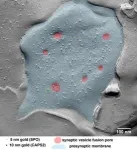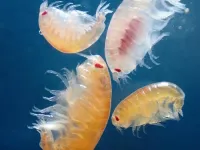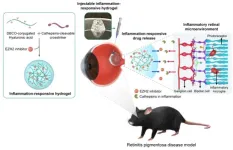(Press-News.org) Fear and addiction exert significant influence within society. Managing them is often challenging, as they are driven by intricate neuronal circuits in our brains. Understanding the underlying molecular mechanisms is crucial to intervene when these processes malfunction. Pioneered by scientists at the Institute of Science and Technology Austria (ISTA), the novel “Flash and Freeze-fracture” technique provides a unique glimpse into the respective brain region. The results were recently published in the journal PNAS.
While looking for food, a bird encounters a fox. It gets away just in time, but the sight and the sound of the predator lingers. The negative experience will form a memory in its brain and will be associated with fear and stress from now on. Whenever it meets a fox again, the fear memory is revived. The bird’s attention spikes, its heart rate goes up, and it changes its behavior to reduce the risk of predation. Such memory is mediated by a specific brain region called the medial habenula, one of the epicenters for emotional processing.
Peter Koppensteiner, together with Pradeep Bhandari, Cihan Önal and other members of Ryuichi Shigemoto’s research group at the Institute of Science and Technology Austria (ISTA) investigated this particular part of the brain to understand how its neurons (nerve cells) communicate with each other. Published in the journal PNAS, the results give an unprecedented look into this subject, utilizing a novel visualization technique called “Flash and Freeze-fracture”.
Counter-intuitive brain cells
Nerve cells in the medial habenula exhibit unusual behavior, contradicting the general understanding of how neurons transmit signals to each other. “Typically, communication between neurons is shut down, as soon as a specific molecule on the surface of the cells, known as the ‘GABAB’-receptor, is activated,” explains Peter Koppensteiner, previously a postdoc in the Shigemoto group and now a staff scientist at one of ISTA’s Scientific Service Units (SSUs). In neurons of the medial habenula, the exact opposite happens. “With the activation of GABAB, communication is elevated, to the extent that it shows the strongest synaptic facilitation throughout the entire brain,” he continues. The underlying mechanism, however, was still unknown.
New method to uncover the inside of neurons
Driven by curiosity, the ISTA scientists embarked on a journey to decipher this phenomenon. The goal was to thoroughly examine medial habenula neurons in mice after they had been activated with a light flash. “It’s a very challenging task,” says Ryuichi Shigemoto. “The processes inside neurons occur in milliseconds, and classical electron microscope methods lack the temporal resolution to capture them.”
A method formulated within the past decade, significantly influenced by Peter Jonas’ research group at ISTA called “Flash and Freeze”, proved to be a great starting point. It is a powerful tool, where neurons are frozen after being stimulated with light, to analyze the structure of neurons. The scientists now elevated it to the next level. Their new “Flash and Freeze-fracture” technique introduces the possibility of also depicting proteins and molecules. This advancement allows researchers to track their trajectories, i.e., where proteins are going after neuronal activation, and reveal why they occupy distinct positions.
The latter is of particular importance. “The communication at the synapse varies depending on the localization of specific proteins. Our new method reveals that rapid position changes of some proteins strengthen the synapses,” explains Koppensteiner. Two proteins with previously unknown functions in particular, SPO and CAPS2, localize near the synapse, where CAPS2 anchors vesicles—tiny bubbles carrying neurotransmitters—to this region. A crucial event that enables a strong release of their messenger signals to the next nerve cell, thus facilitating communication between nerve cells.
Understanding these details could potentially open new doors to actively strengthen synapses in neurodegenerative diseases, where they are not functioning properly anymore.
Shigemoto adds, “I’m beyond excited about this remarkable publication that elucidates the mechanism of this peculiar phenomenon in the brain.”
-
Information on animal studies
In order to better understand fundamental processes, for example, in the fields of neuroscience, immunology, or genetics, the use of animals in research is indispensable. No other methods, such as in silico models, can serve as alternative. The animals are raised, kept, and treated according to the strict regulations of Austrian law. All animal procedures are approved by the Federal Ministry of Education, Science and Research.
END
Neuronal insights: flash and freeze-fracture
ISTA researchers analyze brain region using light flashes, high-pressure freezing and fracturing
2024-02-14
ELSE PRESS RELEASES FROM THIS DATE:
Tiny crustaceans discovered preying on live jellyfish during harsh Arctic night
2024-02-14
In the dark and cold of the months-long polar night, food resources are limited. Some groups of marine organisms in the polar regions overcome this challenge by going into a metabolic resting state in winter, surviving on reserves accumulated during the short growth season. But others, such as several species of marine zooplankton, have evolved a different strategy: they shift from a specialized to an omnivorous diet during the polar night, profiting from a wide range of potentially less rewarding foods that are available throughout the year.
Now, ...
It's award season: let's celebrate microbes in movies
2024-02-14
Elche (Spain), January 22, 2024. Usually, show business depicts viruses, bacteria, and other microorganisms as one of the worst menaces to humankind. Entertainment movies influence the way audiences understand and perceive these topics. Yet, few films accurately portray the science of microbiology and its social implications. Movies and TV series often feature outbreaks of deadly diseases and the efforts of scientists and medical professionals to contain them. However, entertainment movies can also educate the public about the importance and the impact ...
New treatment developed to dramatically slow down the progression of blindness-causing retinal diseases
2024-02-14
The Korea Institute of Science and Technology (KIST) announced that Dr. Maesoon Im of the Brain Science Institute, together with Prof. Seung Ja Oh of Kyung Hee University and Prof. Kangwon Lee of Seoul National University, successfully incorporated anti-inflammatory drugs into a hydrogel to suppress inflammation in the retina and effectively deliver the drugs to the inflamed area.
Age-related macular degeneration and retinitis pigmentosa are incurable eye diseases that cause blindness due to the gradual damage of photoreceptor cells, which convert light into biological signals in the retina, the light-sensitive tissue at the back of the eye. Age-related macular degeneration is a condition ...
Menopause and migraines: New findings point to power of prevention
2024-02-14
For middle-aged women plagued by migraines, or hot flashes and night sweats, another worry may linger in the backs of their minds: whether these experiences have set them up for a heart attack, a stroke or another cardiovascular crisis.
After all, past research suggesting such a link during and after menopause has gotten a lot of attention.
But a pair of new studies in the journal Menopause suggest that most of them don’t need to worry as much, especially if they don’t have both migraines and long-term hot flashes and night sweats.
Instead, they should focus on tackling the ...
The combination of migraine and persistent hot flashes could prove deadly
2024-02-14
CLEVELAND, Ohio (Feb 14, 2024)—Hot flashes and migraine (particularly with aura) have been shown to be individual risk factors for cardiovascular disease because of associated poorer heart disease riskfactor profiles. A new study, however, is the first to examine the joint influences of migraine and hot flashes/night sweats (vasomotor symptoms) independent of traditional heart disease risk factors and estrogen use. Research results are published online today in Menopause, the journal of The Menopause Society.
Specifically, ...
Acupuncture may curb heightened risk of stroke associated with rheumatoid arthritis
2024-02-14
A course of acupuncture may curb the heightened risk of stroke associated with rheumatoid arthritis, finds a comparative study published in the open access journal BMJ Open.
The effects seem to be independent of sex, age, medication use, and co-existing conditions, the findings indicate, prompting the researchers to suggest that the procedure may reduce levels of pro-inflammatory proteins (cytokines) in the body that are linked to cardiovascular disease.
The principal cause of death in people with rheumatoid arthritis is cardiovascular disease. And they are more likely to have a stroke than ...
Poor quality clinical data informing NICE decisions on treatments in over half of cases
2024-02-14
The quality of evidence submitted to the National Institute for Health and Care Excellence (NICE) for informing its decisions to recommend technologies for use in the NHS was poor in more than half of cases, reveals a 20-year analysis, published in the open access journal BMJ Open.
And the data quality submitted for health technology appraisals by manufacturers between 2000 and 2019 was consistently poor, with no improvement during that time, the analysis shows.
NICE advises the NHS on the ...
Age when periods first start and early menopause linked to heightened COPD risk
2024-02-14
A range of reproductive factors, including age when periods first start and an early menopause, are all linked to a heightened risk of COPD—the umbrella term for progressive lung conditions that cause breathing difficulties—finds research published online in the journal Thorax.
Miscarriage, stillbirth, infertility, and having 3 or more children are also associated with a heightened risk of COPD, which includes emphysema and chronic bronchitis, the findings show.
Recent evidence indicates substantial gender differences in susceptibility ...
Hostile environment policies linked to prolonged distress in people with Black Caribbean ancestry
2024-02-14
Psychological distress increased among people with Black Caribbean heritage in the UK, relative to the White population, following the 2014 Immigration Act and the Windrush scandal, finds a new study led by UCL researchers.
The researchers say their findings, published in The Lancet Psychiatry, suggest a causal link between government policies and a subsequent decline in mental health.
They were investigating the impact of the Immigration Act 2014, requiring landlords, employers, the NHS, banks and the police to check right-to-stay documentation. This was a key part of a set of measures known as the Home Office hostile environment policy, seeking ...
Clinical trial shows rheumatoid arthritis drug could prevent disease
2024-02-14
A drug used to treat rheumatoid arthritis could also prevent the disease in individuals deemed to be at risk.
Results from a Phase 2b clinical trial, published today in The Lancet by researchers led by King’s College London, provides hope for arthritis sufferers after it was shown that the biologic drug abatacept reduces progression to this agonising chronic inflammatory disease.
Rheumatoid arthritis affects half a million people in the UK and develops when the body’s immune system attacks itself, causing joint pain, swelling and significant disability. The disease most commonly begins in middle age, but much younger age groups can be afflicted, and until ...
LAST 30 PRESS RELEASES:
A new way to map how cells choose their fate
Numbers in our sights affect how we perceive space
SIMJ announces global collaborative book project in commemoration of its 75th anniversary
Air pollution exposure and birth weight
Obstructive sleep apnea risk and mental health conditions among older adults
How talking slows eye movements behind the wheel
The Ceramic Society of Japan’s Oxoate Ceramics Research Association launches new international book project
Heart-brain connection: international study reveals the role of the vagus nerve in keeping the heart young
Researchers identify Rb1 as a predictive biomarker for a new therapeutic strategy in some breast cancers
Survey reveals ethical gaps slowing AI adoption in pediatric surgery
Stimulant ADHD medications work differently than thought
AI overestimates how smart people are, according to HSE economists
HSE researchers create genome-wide map of quadruplexes
Scientists boost cell "powerhouses" to burn more calories
Automatic label checking: The missing step in making reliable medical AI
Low daily alcohol intake linked to 50% heightened mouth cancer risk in India
American Meteorological Society announces Rick Spinrad as 2026 President-Elect
Biomass-based carbon capture spotlighted in newly released global climate webinar recording
Illuminating invisible nano pollutants: advanced bioimaging tracks the full journey of emerging nanoscale contaminants in living systems
How does age affect recovery from spinal cord injury?
Novel AI tool offers prognosis for patients with head and neck cancer
Fathers’ microplastic exposure tied to their children’s metabolic problems
Research validates laboratory model for studying high-grade serous ovarian cancer
SIR 2026 delivers transformative breakthroughs in minimally invasive medicine to improve patient care
Stem Cell Reports most downloaded papers of 2025 highlight the breadth and impact of stem cell research
Oxford-led study estimates NHS spends around 3% of its primary and secondary care budget on the health impacts of heat and cold in England
A researcher’s long quest leads to a smart composite breakthrough
Urban wild bees act as “microbial sensors” of city health.
New study finds where you live affects recovery after a hip fracture
Forecasting the impact of fully automated vehicle adoption on US road traffic injuries
[Press-News.org] Neuronal insights: flash and freeze-fractureISTA researchers analyze brain region using light flashes, high-pressure freezing and fracturing





